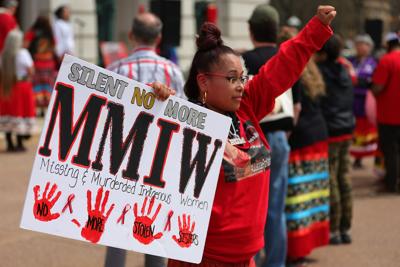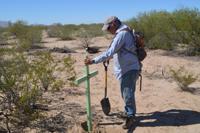
MADISON, WISCONSIN - MAY 05: A demonstrator holds a sign to commemorate Missing and Murdered Indigenous Women and Girls outside of the Wisconsin State Capitol on May 05, 2022 in Madison, Wisconsin.
Emily Pike went missing on January 27, from the Mesa, Arizona group home she lived in.
Weeks later, on Valentine’s Day, the 14-year-old from the San Carlos Apache Tribe was found murdered in Gila County, nearly 100 miles away from where she went missing.
Her death and the subsequent investigation — which has so far indicated that Pike reported being a victim of sexual violence prior to her murder — brought the conversation around Missing and Murdered Indigenous Women and Girls (MMIWG) to the forefront, a movement that has long battled against the systemic discrepancies within the agencies that investigate kidnapping and homicide cases involving this population.
According to an analysis conducted by the Urban Indian Health Institute, of the 5,712 cases of MMIWG reported in 2016, only 116 of them were logged in the Department of Justice database. And of 506 cases reported in 71 cities across the U.S., only 353 were found in law enforcement databases.
For years, activists and community leaders with the 22 federally recognized Native American tribes whose territories fall within Arizona boundaries have called on local governments to do more to help combat the high rates of forcibly disappeared Indigenous people.
On Tuesday, Gov. Katie Hobbs signed House Bill 2281, known as “Emily’s Law”, a legislation that creates a Turquoise Alert System, similar to the existing child Amber Alert, sending out a statewide notification if a person under the age of 65 goes missing under dangerous or suspicious circumstances. The new system would be run by the Arizona Department of Public Safety.
The bill, sponsored by Rep. Teresa Martinez (R-Casa Grande), was initially drafted to specifically address MMIW cases. Martinez’s niece is a member of the Gila River Indian Community. Yet several amendments made the bill’s language more inclusive of anyone gone missing in Arizona under the stipulated circumstances.
Even so, the bill has been largely celebrated by Native American activists and tribal governments, including Gila River and the Navajo Nation — two of the largest reservations in Arizona. The law mirrors similar missing persons alert systems already in place in other states, like Washington, New Mexico and California.
So far, no arrests have been made in Pike's murder case and remains under investigation by the Gila County Sheriff’s Office and the support of the Federal Bureau of Investigation.
Days before Hobbs signed the bill into law, the FBI announced a reward of up to $75,000 for information of those responsible for her disappearance and murder. Anyone with information can call the toll-free tipline at 1-800-CALL-FBI (1-800-225-5324) or can submit a tip electronically at tips.fbi.gov.













(0) comments
Welcome to the discussion.
Log In
Keep it Clean. Please avoid obscene, vulgar, lewd, racist or sexually-oriented language.
PLEASE TURN OFF YOUR CAPS LOCK.
Don't Threaten. Threats of harming another person will not be tolerated.
Be Truthful. Don't knowingly lie about anyone or anything.
Be Nice. No racism, sexism or any sort of -ism that is degrading to another person.
Be Proactive. Use the 'Report' link on each comment to let us know of abusive posts.
Share with Us. We'd love to hear eyewitness accounts, the history behind an article.